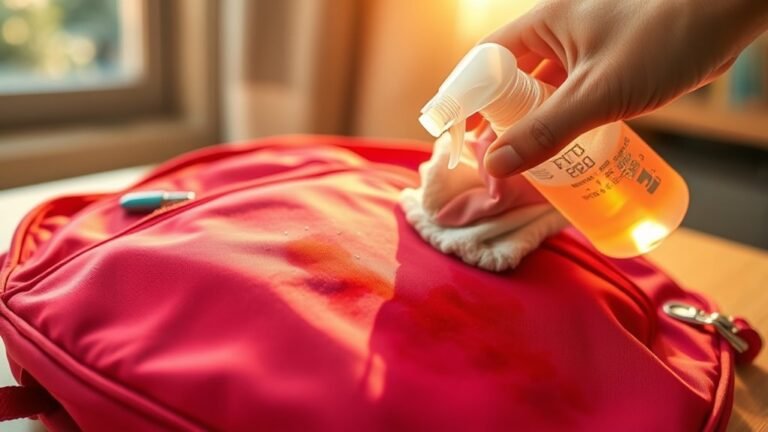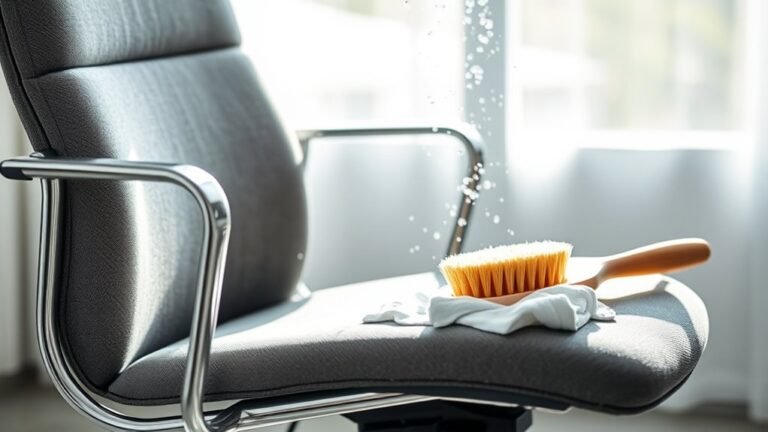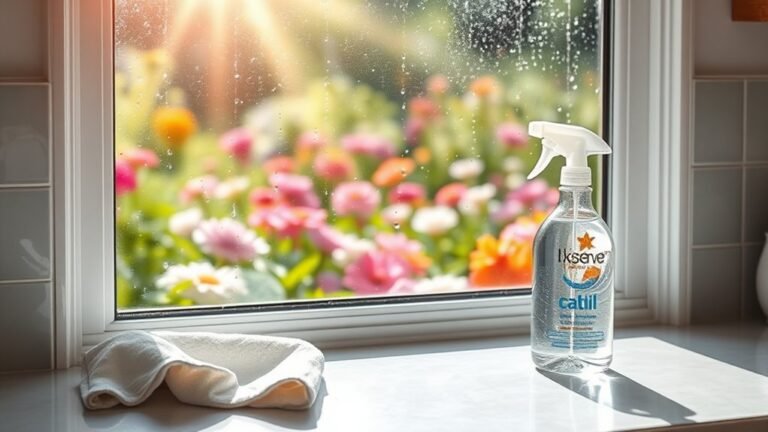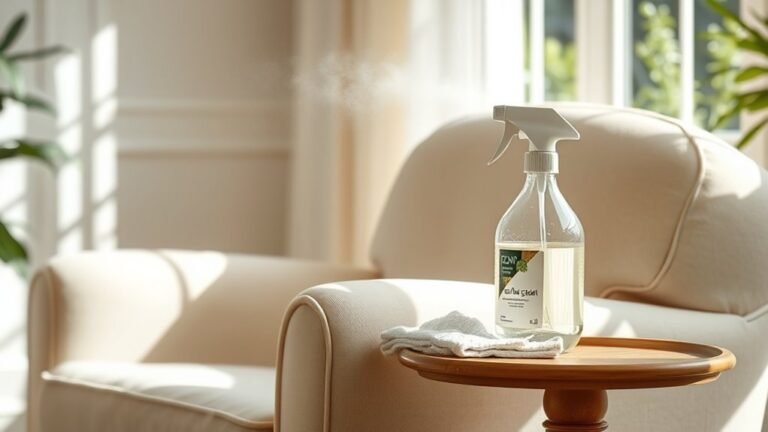Mistakes to Avoid When Cleaning Your Conference Table
When cleaning your conference table, avoid harsh chemicals that damage finishes and always follow the manufacturer’s cleaning guidelines to protect the surface. Don’t overuse water—it can cause warping or mold. Make sure to dust before wiping to prevent scratches, and never use abrasive tools. Address spills quickly with gentle blotting and mild cleaners. Regular maintenance and polishing keep your table looking fresh. Keep these in mind, and you’ll find tips to make your cleaning routine even better.
Using Harsh Chemicals That Damage the Finish

Although it might seem easier to grab strong cleaners, using harsh chemicals can quickly ruin your conference table’s finish. You want to protect the table, not expose it to damaging chemical reactions that strip away its protective coating. When you choose aggressive cleaners, you risk dulling the surface or causing discoloration, which limits your freedom to enjoy a pristine workspace. Instead, opt for gentle, pH-balanced solutions designed specifically for wood or laminate surfaces. This way, you maintain the integrity of the finish protection and extend the table’s lifespan. By avoiding chemicals that react negatively with the finish, you keep your conference table looking sharp and inviting—letting you focus on what really matters without worrying about costly repairs or replacements.
Ignoring Manufacturer Cleaning Recommendations
Choosing the right cleaning products is only part of the equation; following the manufacturer’s cleaning recommendations is just as important. When you ignore manufacturer guidelines, you risk using methods or substances that aren’t compatible with your conference table’s surface. This can lead to damage, discoloration, or a shortened lifespan, limiting your freedom to enjoy a pristine workspace. Manufacturer guidelines are designed to guarantee surface compatibility and keep your table looking its best without unnecessary wear. By sticking to these recommendations, you maintain control over the cleaning process and protect your investment. Don’t let shortcuts or assumptions dictate how you care for your table—respecting the manufacturer’s instructions empowers you to clean confidently and effectively, preserving both the beauty and function of your conference table.
Applying Excessive Water or Moisture
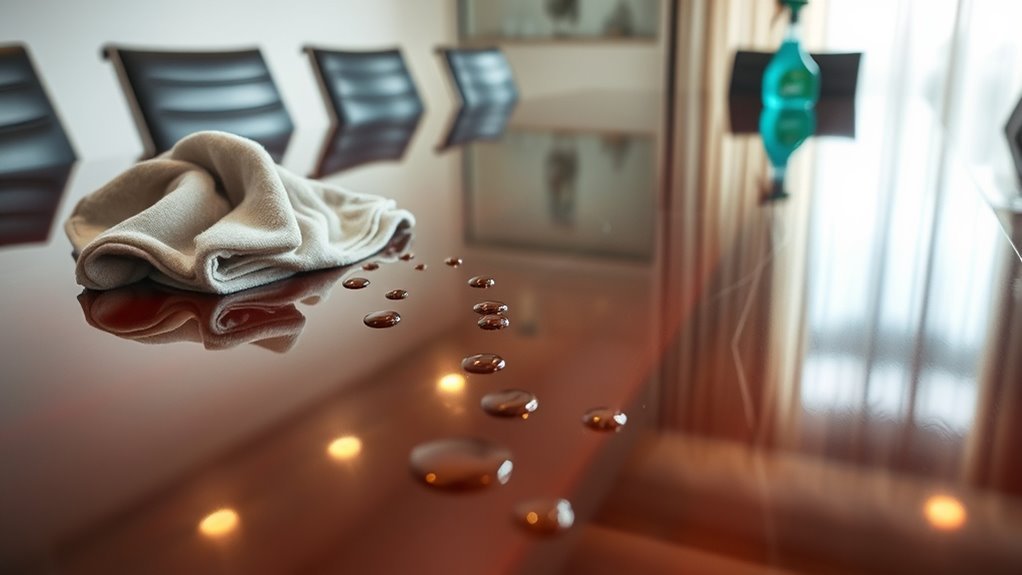
You might think more water means a cleaner table, but applying too much moisture can actually harm wood surfaces. Over-wetting can cause warping, staining, or even mold growth if the table doesn’t dry properly. It’s important to use just enough moisture to clean without soaking the wood.
Risks of Over-Wetting
When cleaning a conference table, applying too much water can cause more harm than good. Over wetting effects aren’t just about excess moisture; they can seriously compromise your table’s integrity. You want freedom from worry, not unexpected damage caused by moisture absorption. Here’s what you risk when you overdo it:
- Water pooling that seeps into seams, leading to swelling or warping.
- Prolonged dampness inviting mold or mildew, which can spread and create odors.
- Compromised finishes that dull the surface and reduce the table’s lifespan.
To keep your conference table looking great and lasting long, use minimal water and dry quickly. You deserve cleaning freedom without risking lasting damage from too much moisture.
Damage to Wood Surfaces
One major mistake you’ll want to avoid is applying excessive water or moisture to wood surfaces, as it can cause lasting damage. When you drench your conference table, the wood can swell, warp, or even crack over time. This compromises both the table’s appearance and structural integrity. For true freedom in maintaining your space, focus on proper wood care by using minimal moisture and effective cleaning methods. Remember, surface protection is key to preserving the natural beauty of your table. Instead of soaking, opt for damp cloths and quick drying. By steering clear of excess water, you safeguard your investment and keep your conference table looking sharp and ready for any meeting.
Proper Moisture Levels
Although it might seem harmless, applying too much water or moisture during cleaning can quickly damage your conference table. Maintaining the right moisture balance is essential to preserving the wood’s integrity and appearance. You want your table to reflect freedom, not constraints from unnecessary damage.
Here’s what to keep in mind:
- Use a damp, not soaking wet, cloth to avoid excess moisture seeping into the wood.
- Monitor humidity control in the room to prevent swelling or warping caused by moisture fluctuations.
- Immediately wipe away any standing water to protect the finish and prevent mold growth.
Neglecting to Dust Before Cleaning

You might think skipping dusting saves time, but it actually leads to dirt buildup that can damage your table’s surface. Dust acts like tiny abrasives, so if you don’t remove it first, you risk scratching the finish when you clean. Always dust before wiping to keep your conference table looking its best.
Importance of Dusting
Before you start wiping down your conference table, make sure you dust it thoroughly. Skipping this step lets dust accumulation build up, making your cleaning less effective and your space feel cluttered. Dusting is essential for:
- Dust Prevention: Removing dust regularly stops it from settling deep into the table’s surface, keeping it fresh longer.
- Protecting Your Workspace: Dust can scratch or dull the finish if ignored, limiting your table’s lifespan and your freedom to enjoy a clean environment.
- Enhancing Health: Dust carries allergens that can affect breathing, so dusting helps maintain a healthier space where you feel free and comfortable.
Don’t let neglect hold you back. Embrace the simple habit of dusting to keep your conference table—and your mind—clear.
Dust Traps Dirt
Many particles of dust act like magnets for dirt, making it harder to clean your conference table if you skip dusting first. When dust accumulation builds up, dirt sticks more stubbornly, requiring extra effort and risking damage during cleaning. Keeping a regular cleaning frequency helps you avoid this hassle and maintain a pristine surface.
| Dust Accumulation Level | Cleaning Frequency | Result on Table |
|---|---|---|
| Low | Weekly | Easy to clean |
| Moderate | Bi-weekly | Requires moderate effort |
| High | Monthly or less often | Difficult, risk of damage |
Don’t let dust trap dirt—embrace dusting as a freedom step to effortless, effective cleaning every time.
Preventing Surface Scratches
Dust not only attracts dirt but can also cause scratches if overlooked during cleaning. When you skip dusting before wiping, those tiny particles can grind against the surface, leaving marks that trap your conference table in a dull prison. To protect your freedom to enjoy a flawless finish, follow these steps:
- Always start with microfiber cloths—they lift dust gently without spreading it around or scratching the surface.
- Use a soft brush or compressed air to get dust out of crevices before wiping.
- Finish with a gentle polish to restore shine and add a protective layer.
Using Abrasive Tools or Scrubbing Pads
While abrasive tools and scrubbing pads might seem like quick fixes for tough stains, they can actually damage the surface of your conference table. Using abrasive materials or harsh scrubbing techniques can leave scratches, dull finishes, and even remove protective coatings. You want your table to look pristine, not worn down by aggressive cleaning. Instead, opt for soft cloths or non-abrasive sponges paired with gentle cleaning solutions. This way, you maintain the table’s integrity and extend its lifespan. Remember, freedom in your workspace means caring for your furniture wisely—avoid shortcuts that cause harm. Be patient and choose cleaning methods that respect the surface, ensuring your conference table stays smooth and inviting for every meeting.
Failing to Clean Spills Immediately
If you don’t clean spills immediately, they can seep into the table’s surface and cause stains or damage. Effective spill management demands immediate action to protect your conference table and maintain its freedom from permanent marks. When a spill occurs, follow these steps:
- Act fast—grab a soft cloth and blot the spill gently without spreading it.
- Use a mild cleaner suitable for your table’s material to remove residue.
- Dry the area thoroughly to prevent moisture damage.
Ignoring spills might seem harmless, but it restricts your table’s lifespan and appearance. Taking control quickly lets you keep your conference space open and inviting, free from unsightly blemishes. Don’t let small accidents limit your freedom to enjoy a pristine table every day.
Overlooking Regular Maintenance and Polishing
Even though daily cleaning is essential, neglecting regular maintenance and polishing can dull your conference table’s finish and shorten its lifespan. You want your table to look sharp and inviting, not worn and tired, right? By committing to regular inspection, you’ll catch early signs of wear or damage before they become serious. Surface conditioning isn’t just a fancy term—it’s a crucial step that restores shine and protects the wood or material underneath. Skipping these steps might save time now but will cost you in the long run, limiting your freedom to enjoy a flawless workspace. Make maintenance a simple habit; it keeps your table looking fresh and extends its life, giving you the freedom to focus on what truly matters.
Using Inappropriate Cleaning Products for Material Type
Choosing the wrong cleaning products for your conference table’s material can cause more harm than good. If you want to maintain its beauty and durability, you need to respect surface compatibility. Using harsh chemicals or unsuitable cleaning materials might damage the finish, stain the surface, or even warp the wood. To keep your table looking its best, avoid these mistakes:
- Using abrasive cleaners on delicate surfaces—this can scratch and dull the finish.
- Applying ammonia or bleach-based products on wood or laminates—they strip protective coatings.
- Ignoring manufacturer recommendations for cleaning materials, which are tailored to your table’s specific material.
Skipping Protective Measures During Cleaning
Using the right cleaning products is just one part of protecting your conference table. You’ve got to take the extra step by wearing proper protective gear—gloves and even eye protection—so you stay safe while tackling grime. Skipping these measures not only puts you at risk but can also lead to careless cleaning that damages the table’s finish. Surface protection is equally vital; don’t neglect to lay down a soft cloth or protective pads beneath cleaning tools to avoid scratches or dents. When you commit to these simple precautions, you maintain your table’s integrity and enjoy the freedom to clean confidently without worry. Remember, safeguarding yourself and the surface means your conference table stays pristine longer, giving you more time to focus on what really matters.
Frequently Asked Questions
How Often Should I Deep Clean My Conference Table?
You should set a deep cleaning frequency based on how often your conference table gets used. If meetings happen daily, deep clean it every one to two weeks to keep it fresh and inviting. Otherwise, once a month might work. Establish a cleaning schedule that fits your freedom to manage tasks without stress—something flexible but consistent enough to maintain a professional look and extend your table’s life.
Can I Use Homemade Cleaning Solutions Safely?
Did you know 70% of people prefer homemade cleaners for their eco-friendliness? You can definitely use homemade cleaning solutions safely, but you’ve got to take safety precautions. Always test a small area first to avoid damage, and avoid mixing ingredients like vinegar and bleach. Using simple ingredients like vinegar, baking soda, and lemon can be effective and give you freedom from harsh chemicals while keeping your conference table clean and safe.
What Should I Do if My Table Has Water Stains?
If your table has water stains, you’ll want to act quickly for effective water stain removal. Start by gently blotting the area with a soft cloth to avoid spreading the stain. Then, try a mixture of equal parts vinegar and olive oil—apply it carefully to maintain table surface care. This combo can lift stains without damaging the finish, giving your table a fresh look while keeping your freedom to enjoy your space worry-free.
Are There Eco-Friendly Products Suitable for Conference Tables?
You’ll be glad to know there are plenty of eco-friendly products perfect for your conference tables. Biodegradable cleaners break down naturally, so you’re not harming the planet while keeping your space spotless. Natural disinfectants, like vinegar or tea tree oil, kill germs without harsh chemicals, giving you peace of mind and freedom from toxins. Choosing these options lets you maintain a clean, safe environment without compromising your values or health.
How Do I Repair Minor Scratches on the Table Surface?
When it comes to scratch repair, don’t beat around the bush—start by cleaning the surface with a soft cloth. You can use a wood filler or a scratch repair marker that matches your table’s finish to fill in minor scratches. Afterward, apply a surface protection product like a clear coat or wax to keep it looking fresh. This way, you maintain freedom from constant touch-ups and keep your table looking sharp.


